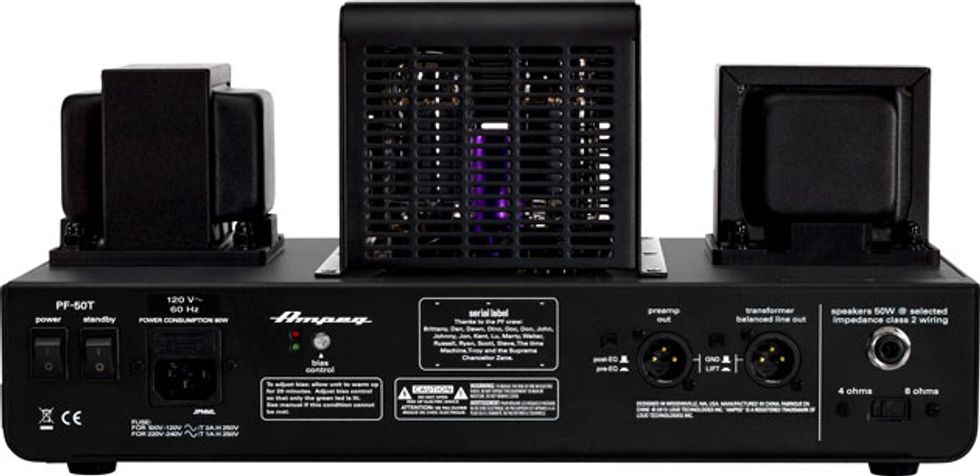Ampeg’s huge impact on the world of bass amplification is no secret. The SVT is a standard onstage rig and the B-15 is a staple in recording studios the world over. Not only has Ampeg set the bar high for the rest of the amp realm over the years, but for themselves in their quest to push forward in designs and features, yet maintain a respectful nod to the tone and builds that made them so significant in the first place. Enter the new all-tube PF-50T—a flexible, rock-solid amp that captures the spirit of Ampeg classics of the past, and offers an innovative feature that should be an industry standard. Same but Different The “PF” in PF-50T is short for Portaflex—a salute to Ampeg’s iconic flip-top B-15 head. The design of the PF-50T is super slick, yet still brings back memories of the old days with its two massive transformers and a steel cage that houses five tubes on top. Not to be confused with the B-15 Heritage (the flip-top reissue in the family), the PF-50T has been engineered to bridge the gap between the B-15 and the SVT with moderate power, tube warmth, and more than a hint of saturation available.
The 20-pound PF-50T has two inputs—one for passive instruments and the other with a 15 dB cut for active instruments. The control set is easy enough: gain, Ampeg’s well-known ultra-hi and ultra-low EQ buttons, bass, midrange, a 5-way midrange sweep, treble, and, finally, a master volume. The rear panel is also uncomplicated, with the exception of one very cool feature: twin XLR outs.
Why would Ampeg put two DIs on the PF-50T? Well, the first DI can be run either pre or post EQ. The second DI is an output straight from the transformer, which is basically what you would send to a cabinet. Let’s say you are allowed two channels in the FOH console at your next gig. Your engineer can have both your untouched clean signal and your dialed-in tone to work with. Or say you’re silent recording at home with the PF-50T (no cab required!).
 You can run both DIs at the same time—one clean and one dirty. You don’t have to have a splitter to lay down one clean take while you are using the amp to saturate tone. Whether you’d like to blend the signal or need to fix something later on the clean track, the option is there. Pretty killer.
You can run both DIs at the same time—one clean and one dirty. You don’t have to have a splitter to lay down one clean take while you are using the amp to saturate tone. Whether you’d like to blend the signal or need to fix something later on the clean track, the option is there. Pretty killer.
It’s in There When powering up the amp, the indicator light illuminates red in standby mode and purple for go mode. I plugged in a few instruments for this review: a vintage Fender P, a Music Man StingRay, and a Fender Bass VI. And to keep it in the family, I paired the PF-50T with a 1965 Ampeg 1x15.
I let the PF-50T warm up for a good 20 minutes. The glow of the two massive 6L6s, the 12AU7, and the pair of 12AX7s was a welcome sight for an old soul like myself. (Word of caution: The steel housing for the tubes gets very hot.) The bass I sort of had to plug in first was the vintage P strung with flats. I eased the bass to 1 o’clock, engaged the ultra-low switch, and left the rest of the controls at noon. For a moment, I closed my eyes and I was in the snake pit at Hitsville, U.S.A., hoping to open them and see Smokey Robinson writing lyrics next to me. It was all the vintage warmth you would expect. And when scrolling through the mid sweeps, it’s a snap finding a sweet spot to your liking.
But what if you aren’t a rock or Motown sort of player? Well, the PF-50T can produce great slap tones too. Engaging both the ultra-hi and ultra-low switches, scooping some of the mids, and with bass and treble both around 3 o’clock, the amp sings a different tune. The definition really pops, and clean, articulate fingerstyle players will be right at home. The active StingRay was a littlemuch for the amp because its tone is a bit pointed to begin with, but I was able to tone things down a touch with the EQ and keep its snap and pop with a great balance of rumble.
The Fender VI was a lot of fun with the PF-50T when I dimed the gain and pushed the amp into nasty mode. The tube saturation was really pleasing and the user-friendly EQ made the 6-string jump out pretty quickly. I should again stress the coolness factor of being able to run the dual DIs, especially with an instrument like the VI that lends itself to the new era of guitarless duos.
The Verdict It’s not hard to fall in love with the tube tone of the PF-50T. For all this amp gives bassists, however, there are some features Ampeg left off that some players are accustomed to—like an effects loop, tuner out, and headphone out. While it might not boast a host of bells and whistles, the PF-50T excels where it’s supposed to. It’s a straightforward amp with plenty of power and tube-tone nirvana for the stage or studio. Don’t take my word for it—get to an iso room and test this little gem out yourself.
